Table of Contents
Regulatory compliance is a team sport, and guess who the MVP is? Your suppliers.
If your suppliers aren’t actively engaged in providing compliance data, you’re stuck chasing documents, begging for responses, and constantly firefighting when audits roll around.
The companies that win at compliance are the ones that turn supplier engagement into a long-term partnership—not a one-time transaction. In this post, we’ll discuss how to maximize supplier engagement, reduce friction in data collection, and make compliance a collaborative effort rather than a constant battle.
Why Supplier Engagement Matters
Many companies assume that compliance is their problem. But the reality is, your suppliers hold the key to your compliance success.
Here’s why engagement is crucial:
- Faster Response Times: The more engaged your suppliers are, the quicker you get the compliance data you need.
- Higher Data Accuracy: Suppliers who understand the importance of compliance provide better, more complete data.
- Stronger Supply Chain Relationships: A compliance-first culture fosters trust and long-term collaboration.
- Reduced Compliance Costs: When suppliers proactively provide the right data, it reduces the need for costly lab testing or last-minute regulatory fixes.
The bottom line? Engaged suppliers make compliance easier.
Building a Supplier Engagement Strategy
The key to engagement isn’t sending more emails—it’s about building relationships and incentivizing participation. Here’s how:

1. Make Compliance a Priority from Day One
The best time to establish compliance expectations? Before a contract is signed.
- Include compliance obligations in supplier agreements.
- Set clear expectations for data submission timelines.
- Require suppliers to designate a compliance contact in their organization.
When suppliers know compliance is a condition of doing business, engagement becomes automatic.
2. Speak Their Language (Literally & Figuratively)
A major barrier to supplier engagement is language and complexity.
- Offer multi-language support for global suppliers.
- Provide clear, simple guidance on what data is needed and why.
- Avoid compliance jargon—break down requirements into actionable steps.
Suppliers are more likely to respond when compliance feels manageable, not overwhelming.
3. Build a Relationship, Not Just a Request List
If the only time suppliers hear from you is when you need a declaration, you’re doing it wrong.
- Hold compliance workshops to educate suppliers on regulatory trends.
- Recognize and reward top-performing suppliers.
- Assign a dedicated supplier liaison to maintain ongoing communication.
When suppliers feel valued and informed, they’re more likely to prioritize your requests.
4. Use a Milestone-Based Approach
Supplier engagement isn’t an all-or-nothing process—it’s a journey.
- Phase 1: Focus on critical, high-volume suppliers.
- Phase 2: Expand to smaller, but still essential, suppliers.
- Phase 3: Develop a strategy for onboarding new suppliers.
This approach prevents overwhelming your team while keeping momentum high.
5. Leverage Multi-Shift & Multi-Channel Communication
Global supply chains operate across different time zones and working styles.
- Use multi-shift teams to cover global suppliers efficiently.
- Mix emails, phone calls, and supplier portals for better response rates.
- Offer live support or chat options for real-time engagement.
The easier you make it for suppliers to communicate, the more engaged they’ll be.
6. Prioritize High-Impact Suppliers Using the 80/20 Rule
Not all suppliers contribute equally to your compliance burden.
- Identify the top 20% of suppliers that provide 80% of your materials.
- Focus engagement efforts where they will have the most impact.
- Develop an escalation process for high-risk, low-response suppliers.
By prioritizing strategically, you maximize effort while minimizing frustration.
Overcoming Common Supplier Engagement Challenges
Even the best strategies face hurdles. Here’s how to navigate common engagement roadblocks:
Challenge 1: Suppliers Ignore Requests
Solution:
- Escalate through procurement—if compliance is a business requirement, make it clear.
- Adjust messaging—make the request clear, direct, and action-oriented.
- Offer support and guidance—sometimes suppliers need education, not pressure.
Challenge 2: Suppliers Provide Incomplete Data
Solution:
- Break requests into smaller, manageable tasks like reducing number of parts or regulations per request.
- Use supplier portals that validate data before submission.
- Develop standardized templates to reduce confusion.
Challenge 3: Language & Cultural Barriers
Solution:
- Provide compliance guidance in multiple languages.
- Use visual guides and flowcharts to simplify complex requirements.
- Partner with regional compliance consultants to bridge cultural gaps.

The Future of Supplier Engagement: Collaboration Over Compliance Policing
The companies leading the compliance game understand that supplier engagement isn’t about policing—it’s about partnering.
When compliance is a shared goal, everyone wins:
- Suppliers feel empowered, not pressured.
- Compliance teams spend less time chasing documents and more time managing strategy.
- Companies reduce compliance risk and cost.
So, ask yourself—are you building supplier relationships, or just collecting data?
Learn about Leveraging Automation in Compliance Management—because engagement is just the beginning. Smart companies don’t just collect data—they automate and analyze it for strategic advantage.
